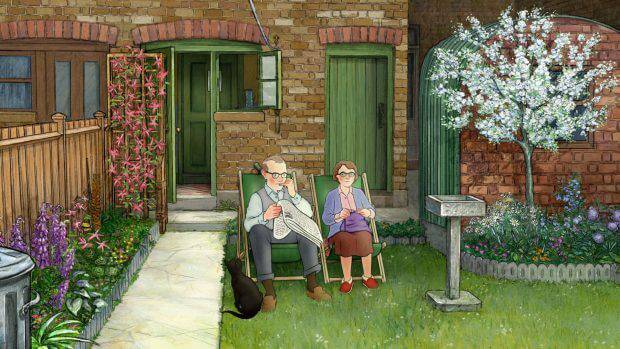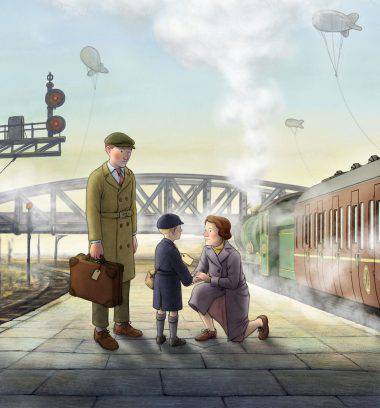Ethel & Ernest – Review
Home grown, hand drawn animated features are a rare and cherished thing in the UK so it is with great anticipation that Ethel & Ernest has made its way into cinemas. The film as it is based on the graphic novel by Raymond Briggs and so carries with it high expectations. Briggs creations have resulted in some of British animation’s finest moments with The Snowman, When the Wind Blows and Father Christmas all attesting to this. So far, these stories have all remained in the realm of fantasy which translates to animation very well, but Ethel and Ernest takes a step away from the allegory and towards autobiography.
The deeply personal nature of the story contributed to the authors initial refusal to back an adaptation of the film when approached by the late John Coates of TVC, a much celebrated figure in UK animation. After securing permission Coates unfortunate passing led to the film being handed over to Lupus Films with Roger Mainwood as director. Adapting Briggs most personal story with the legacy of one of UK animation’s most prominent and respected producers sets up quite a daunting task for any team yet it is one that has been executed with an unmistakable respect for the film and its legacy.
On the surface Ethel & Ernest is a tale of ladies maid Ethel and milkman Ernest as we follow their lives through the years. As with the book, don’t expect a story that leads to a climactic car chase or a “MacGuffin” that the cast are in search of, this is a film where you simply spend time in company of characters. This could be the considered a weak part of this film and the uninviting idea of watching a couple growing old in a house isn’t what entertaining films, animated or otherwise, are usually made of. However, the charm of the characters and the pacing of the story make this unusual story structure a defining highlight of the film. As we share in the couples reactions to contemporary events there are some wonderful character moments such as Ernest being forced to explain his “One yank and they’re down” quip to his bemused wife or his conversation with a friend who is dealing with the ravenous sexual appetite of his menopausal wife. Ethel also has her moments, wether it be her upper class aspirations or handling her neighbours questioning of Raymond’s run in with the police. Their differing political views and marital squabbles are nothing short of charming and are wonderful, succinct character studies. Jim Broadbent and Brenda Blethyn are pitch perfect in their roles which see the characters develop. Broadbent stand out performance sees him in the convincing role of a cheeky young man through to a caring father the characters age and develop. The performances deliver comedy, drama and pathos throughout.

Alongside the faithfully adapted story is an animation style evocative of Raymond Briggs work. Both the hand drawn elements and the CG which is employed throughout blend together nicely. The line work of the animation isn’t too cleaned up and clinical and colours have been selected which faithfully adapt the authors style into animation. The characters ruddy complexions and the layered up, crayons, watercolour and gouache colours of the backgrounds create a tangible world that brings the story to life on screen as it does in the book. Though the film does use a minimal artistic licence with the staging of shots in comparison with the book, there are noticeable moments of the film where staging is copied directly from the book. When these moments are presented they are done so in a way which recreates the anguish of the author and I daresay exaggerates the emotional power of the book.

Criticisms of this film have mainly centered around the story. The fast pacing leads to questions being asked about the character reactions to events as the years fly by swiftly and we are never left to wallow or consider the characters further thoughts as we can do with the book. Criticisms such as this seem to ignore how richly layered the story becomes when transferred to animation and the fast paced story of Ethel and Ernest becomes not just about the couple, but more about the time that they inhabit and how it reflects upon them historically, socially and personally. This is a story of the 20th Century, of London and of the mundane beauty of marriage. Whilst the historic and social aspects of the story are interesting, the characters personalities that drive this film. At times, this makes you feel a part of their family, Ethel and Ernest could be your uncle and aunt retelling the story of their life, and whilst nothing much happens you hang on to their every word.
The daunting prospect of adapting this almost autobiographical story is a task that Mainwood and the team at Lupus and their creative partners have accomplished in a stylish and respectful way that secures Ethel & Ernest a loved and remembered place not only alongside it’s predecessors that Briggs provided the source material for, but also in UK animation history. It will be shown on the BBC at Christmas, but to indulge in the artwork and to appreciate the scale of what has been achieved, you must really see this in the cinemas.
Home grown, hand drawn animated features are a rare and cherished thing in the UK, and when they’re as magnificent as this it becomes abundantly clear why we cherish them.
Ethel and Ernest is in UK cinemas now.
Visit director Roger Mainwood’s production blog here or the films official website here. Listen to Director Roger Mainwood and Art Director Robin Shaw on the Skwigly Animation Podcast below.


